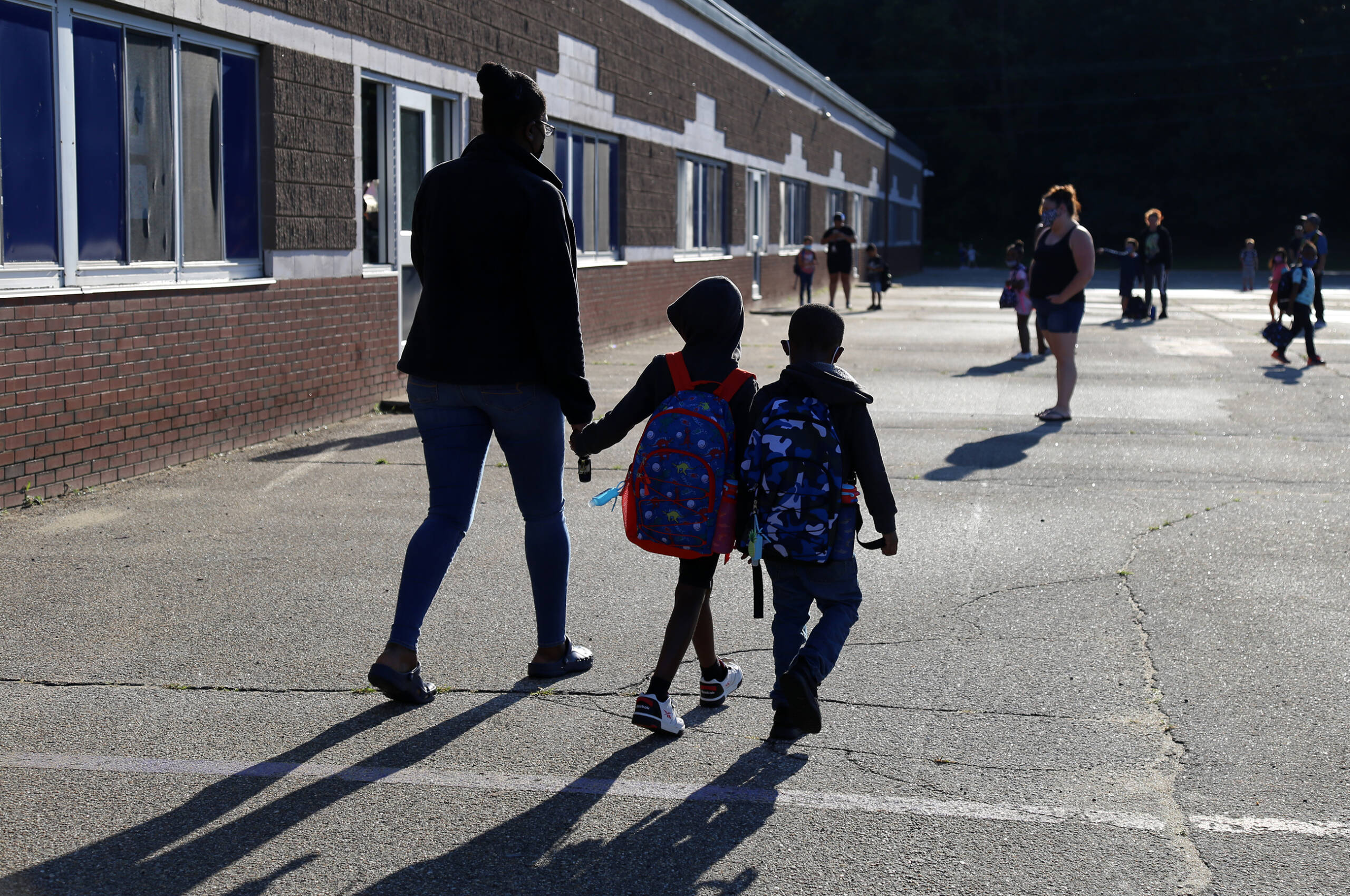Above: Watch The State We’re In interview with the Equity in Education Reporting Team.
 Public education in New Hampshire stands at a crossroads.
Public education in New Hampshire stands at a crossroads.
While schools continue adjusting to the ongoing effects of the COVID-19 pandemic, they’re also at the center of state-level discussions about what and how students should learn — and who should pay for their education.
The launch of “education freedom accounts,” which aim to give more students the ability to seek public education alternatives, has spurred concerns about private and religious schools diverting funds from local districts. Legislative language that prohibits “inculcation” of certain ideas in the classroom — including teaching that one group of people is inherently racist or sexist, or superior or inferior to another — has recently sparked discussions on discrimination, censorship and erasure. Meanwhile, the future of school funding in the Granite State hangs in the balance with the state’s funding formula under scrutiny in the courts.
These and other conversations are coming to the fore as the state becomes more diverse, especially among school-aged children.
Over the next few months, Manchester Ink Link, the Granite State News Collaborative and its partners, will explore these and other topics in a series of articles about New Hampshire’s education system as part of its race and equity reporting project.

“As the largest and most diverse city in Manchester, the question of equity in education is a pivotal one here in Manchester,” said Manchester Ink Link Publisher Carol Robidoux. “This series will focus on solutions based on statewide data. We hope to hear from readers – in particular, teachers and students, who have had to deal with the disruption and modification of teaching and learning during this pandemic. To that end, we encourage teachers to participate through a closed Facebook group, Teachers off the Record, which will be a confidential space where teachers can speak freely about some of the challenges or frustrations they’ve encountered – and possible solutions they’ve seen in action. This is one way of giving voice to educators who often don’t feel safe or comfortable speaking out about what they see and hear in the classroom.” [You can fill out the teachers survey for Teachers Off the Record here.]
The stories seek to amplify voices and explore concerns while highlighting what is working and the communities spearheading solutions. In fact, we’re launching the series with an article examining how one New Hampshire high school is bringing new perspectives into the classroom to help students explore race and justice.
“We know this journalism is essential. Our governor recently claimed systemic racism does not exist in our state. Granite Staters, and even national pundits, often refer to ‘Lily White New Hampshire,'” said Granite State News Collaborative Director Melanie Plenda. “We aim to educate the state about itself and help New Hampshire’s diverse history and reality become part of the public conversation on this issue.”
Shifting demographics
While most of New Hampshire — almost 90 percent, according to 2019 census estimates — is non-Hispanic white, there are pockets of diversity in the state, and some parts of the education system have struggled to serve a changing population.
“Almost 40 percent of the children in Manchester and Nashua are minorities. Those kinds of numbers are not that different from what you would see in bigger urban areas,” said Ken Johnson, a senior demographer at the University of New Hampshire. “So in a sense, some parts of New Hampshire are becoming increasingly diverse at a much more rapid rate than other parts of the state are.”
Though the state’s demographic shifts are relatively recent, members of marginalized communities in New Hampshire say inequities are not new: The state’s schools have long served some learners better than others, with poor students, students with disabilities and students of color most often left behind.
Advocates argue that the state’s funding system creates inequity, with local property taxpayers shouldering the burden of paying for schools. The state’s definition of an “adequate education” — the subject of a lawsuit working its way through the court system — gives schools about $3,800 per student, and some districts receive extra money based on socioeconomic factors, like the percentage of students eligible for free and reduced lunch or receiving special education services.
But districts actually spend an average of $15,000 to $17,000 per child, according to the New Hampshire School Funding Fairness Project. Local property tax revenue bridges the gap, putting cities and towns with lower property values at an immediate disadvantage. And the chasm in resources from community to community is large — Newington has about $15 million worth of equalized property value per child, for example, while Manchester has about $860,000, and Berlin less than $500,000.
"Students of color and low-income students tend to live in these property-poor communities. But then being in a property-poor community creates this economic inequity doom loop, where businesses don't want to move to an area that doesn't have good schools," New Hampshire School Funding Fairness Project Communications Manager Molly Murphy. "So they don't get the tax revenue that they need for their schools, and it's just a repeating cycle."
Less funding can translate to fewer opportunities for students, like a lack of extracurricular activities or even limited course options. As examples, Murphy pointed to Berlin, which had to cut its chemistry teacher, and Pittsfield, where there are no foreign language teachers on staff.
Vulnerable students also miss opportunities in other ways, such as lost classroom time, as they are often subject to harsher discipline than their white and able peers.
A 2016 report from the Carsey Institute at UNH found students of color, students with disabilities, homeless students and those eligible for free and reduced lunch were "considerably" more likely to receive a suspension in the state's middle and high schools. Male students were more likely to be disciplined than others, and incidences of suspension and expulsion were higher in the state's urban schools.
More recent federal data shows similar disparities — in 2017, nearly 33 percent of out-of-school suspensions in the Manchester School District were given to Hispanic or Latino students. However, that group made up only 23.5 percent of the enrollment. Additionally, students receiving special education services accounted for nearly 30 percent of out-of-school suspensions though they made up just 19 percent of the student body.

Though student populations are becoming more diverse, it's unclear whether the same change is occurring among the workforce of educators guiding them. The state doesn't publish annual data on the demographics of educators, but in 2011-2012, 97.8 percent of teachers in the state were non-Hispanic white, according to the National Center for Education Statistics.
What's more, advocates say these students rarely see the culture and history of their communities accurately reflected in the school curriculum.
"It became kind of a daunting problem that there's no K-12 indigenous educational format at all," said Paul Pouliot, grand chief of the Cowasuck Band of the Pennacook-Abenaki People, based in Alton. "And any time there's any effort to do one, it gets whitewashed."
And when advocates and community leaders call for change, they say they encounter resistance and an unwillingness to examine the ways New Hampshire hasn’t met the needs of those who are vulnerable or nonwhite.
"It's this idea of American exceptionalism that, when applied more regionally, becomes New England or New Hampshire exceptionalism," said Manchester NAACP Vice President Woullard Lett. "But the issues that we're looking at are part of larger societal issues that are truly in New Hampshire, just like it is in the rest of the country."
That can leave people with marginalized identities feeling ignored — including by journalists.
"New Hampshire news coverage doesn't spend enough time looking at how impactful the lack of equity is for students with disabilities, whose outcomes are often worse than other vulnerable students," said Lisa Beaudoin, executive director of Able NH.
Help us tell your story
The collaborative partners agree that the community should drive this work. That's why the organization is coupling its coverage with an outreach campaign to get feedback and insight directly from Granite Staters.
We have an initial survey for teachers, who will have the opportunity to join a closed Facebook group called Teachers Off the Record. Here teachers will be able to participate in confidential, guided conversations about teaching and learning in the Granite State. This will also be an opportunity for teachers to interact with local reporters and editors, and help guide the series. For students, we've developed an informal survey to gather ideas about what's working and what isn't in New Hampshire classrooms.
As part of the series, we will be releasing studies and data that we’ve gathered about education in New Hampshire. We’ve created a Data Library to make this information easier to share and understand. Each piece of information comes with details about where it comes from and what we did with it.
We hope that these efforts will inform our reporting and help us understand what families, students and schools want from education in the Granite State — and what they need to make the system work for everyone.
 To become involved in guiding our coverage of education inequity in New Hampshire, contact Granite State News Collaborative engagement reporter Nour Habib at nour.habib@collaborativenh.org.
To become involved in guiding our coverage of education inequity in New Hampshire, contact Granite State News Collaborative engagement reporter Nour Habib at nour.habib@collaborativenh.org.
RELATED STORIES

Exploring Race & Diversity Beyond the Classroom: Inside Exeter's Racial Unity Team







